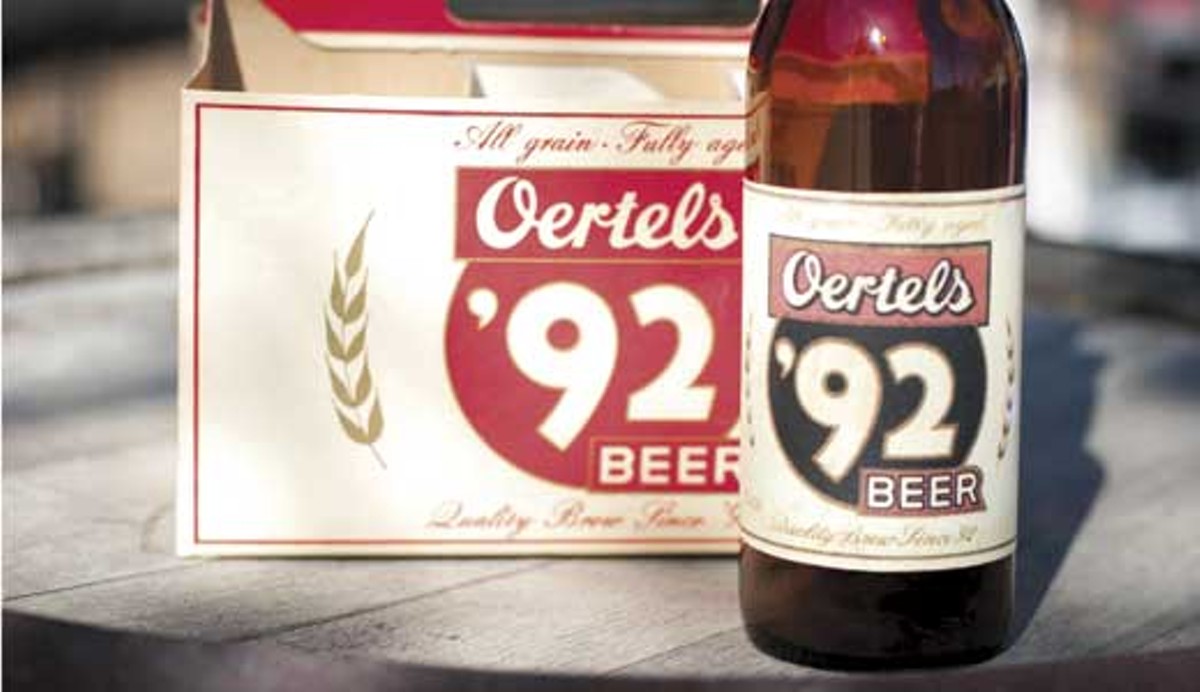The only thing better than getting to write a book about beer is getting to write a book about beer while actually drinking beer. So, that’s how I spent my spring this year.
“Louisville Beer: Derby City History on Draft” was released Sept. 2 by the History Press, and it represents a heck of a lot of work, time and passion – along with plenty of beer. (As I note in the book’s acknowledgements, I won’t say I was ever inebriated while working on the book, but I will say I am very thankful for editors.)
But the work was gratifying – the brewers and brewery owners, and the beer enthusiasts in general, in Louisville are wonderful people. Without fail, the people I worked with were extremely cooperative and helpful as I put the book together. They let me into their space with photographers, gave me their time and granted me access to their artifacts.
Louisville’s brewing history has fascinated me for decades, ever since I procured a copy of “Louisville Breweries: A History of the Brewing Industry in Louisville; Kentucky; New Albany and Jeffersonville” by Peter Guetig and Conrad Selle back in the 1990s.
And what I have found in discussing the book with people is that many in Louisville don’t realize just how rich the history is. With the popularity of so-called “craft” beer (I still prefer to just call it “beer,” but whatever), it seemed like a good time to remind folks that Louisville was indeed one of the top brewing cities in America once upon a time, and to take a look at the social and cultural importance of beer in Louisville over the last 175 years or so. Only Prohibition and corporate mega-brewers managed to choke out brewing in Louisville in 1978, when Falls City took its last gasp with the ill-fated Billy Beer.
But guess what? We’re back. No, we’ll likely never be the mega-brewing center we once were, but I feel that for those who remember the days when Falls City, Oertel’s and Fehr’s beer was what Louisville was drinking, this is a story that should be re-told and updated through the present day.
As such, here is an excerpt from the book:
What Was Louisville Drinking?
We know that Louisville enjoyed an intense love affair with beer during the late 1880s and early 1900s, and we know that lager beer and “common” beer were the two main staples. But what did that beer taste like? That’s nearly an impossible question to answer, in part because most of those early recipes no longer exist and in part because it would be impossible to precisely re-create the exact ingredients. Brewing is a science, but it is also an art; a good brewer adds subtle touches to set his or her beer apart.
Those artistic touches died with those brewers many generations ago. Louisville beer was often made with local water and barley, but hops were imported from East Coast cities, so it’s difficult to tell exactly what those beers might have tasted like. But it can be presumed that the flavors were much stronger than the mass-produced beer that has dominated American palates for decades—probably to the point that the brewers of the day would laugh heartily if they tasted the corporate swill that so many people drink today. Of course, beer wasn’t necessarily welcomed by many whiskey-loving Louisvillians in the early days of its rise in the city. An 1868 article in the Courier-Journal describes beer like this: “Beer, as almost everybody knows, is an amber colored fluid, with a flavor peculiar to itself, which pleases some and is repulsive to others.” The article cites that one writer “thought he had a parallel for the flavor…[likening] it to soap suds in which a pickle has been soaked.”
Doesn’t sound particularly accurate to me. Regardless, while we can’t know for sure exactly what flavors Louisvillians were drinking in the late 19th and early 20th centuries, it’s still fun to speculate, right? So that’s what we’ll do now. Lager was probably the beer that was the second most quaffed in Louisville during the city’s beer boom. Lager is a traditional German beer style that is distinguished not only by how it is made but also by its crisp body and flavor. Typically, a lager will taste quite a lot like the grains with which it is brewed, and it can sometimes taste “grassy” or like freshly mown hay.
But lagers also are hopped and malted, leading to varying levels of bitterness and body, depending on the types of hops and malts used and the amount. In addition, lager beer is fermented for longer periods of time than ale or common beer, as well as at lower temperatures. This production necessity made the brewing of lager beer difficult in days when ice was scarce or expensive, which is no doubt why Phoenix and other breweries created underground tunnels to ferment the wort to make this bright, crisp beer. One can only imagine that if Louisvillians in the early 1800s were brewing and drinking primarily ales, stouts and porters, a first taste of lager with the influx of German brewers must have been quite a revelation—or perhaps a revulsion.
A German settler named Joseph Jaeger was credited with being the first man to bring lager beer to Louisville in his 1901 obituary in the Courier-Journal. Jaeger died at age 80, and although the short article does not reveal the year of his arrival, Jaeger is credited with having lager beer contract-brewed in Cincinnati and then delivered here. This could have been in the early 1840s, depending on the age Jaeger was when he did so.
During Louisville’s brewing heyday, classic amber lager and darker lagers were brewed, with the body and color owing to the malts used. Guetig and Selle identified Phoenix Amber, for instance, as a Munich-style lager that would have carried a more intense flavor than the lighter, straw- yellow lager beers of the day. One would imagine that on a hot summer day at Phoenix Hill Park or Woodland Garden, the paler, crisper lagers would rule the afternoon, while the darker lagers might be more enjoyable on a chilly fall evening. But the early breweries in Louisville made ales—one of them was Nadorff Brewing Company, which brewed beers that show up in advertisements of the day often as XXX Ale or XXXX Ale. The former was probably a hoppy, bold beer, probably about 70 or 80 IBU, two to three times more bitter than a lager, according to Guetig and Selle. The book also notes that porters and stouts of the early breweries probably were simply hoppier versions of what we know today, with stouts likely being as hoppy as the ales.
Cream beer was another staple and was the cheap, light beer of its day. Lacking the bite of a lager beer, cream beer was just what it sounds like—light and smooth and less likely to get you drunk. This was no doubt a summertime favorite in the saloons. The cream beer that was hugely popular in Louisville is now known as Kentucky Common. Known merely as “common beer” at the time, it is basically a cream-style beer that was made with about 25 to 30 percent corn along with caramel and/or roasted malts for a dark amber hue and a bit more flavor than lighter cream beers. By the early 1900s, it was the most popular beer in the city; it is estimated that by 1915, 80 percent of the beer consumed in Louisville was common beer. Conrad Selle provided me with this translated quote from the German- language newspaper Louisville Anziger, from 1909:
“Beer has conquered the world. But one thinks…that this refers to lager beer. In Louisville, however, the beer drinker can enjoy double pleasure, as they can along with the lager beer enjoy the “common beer,” a really great and increasingly popular product. It is a healthful, light, pleasant drink that people in other large American cities are for the most part unaware of. Perhaps its popularity, which it has always enjoyed here, would not be as great if, with improved brewing methods, better stuff had not become available. The best common beer in Louisville is the Cream Beer of the Butchertown Brewery.”
In fact, Kentucky Common is one that is occasionally replicated— or, rather, attempts to replicate it are made—by Kentucky breweries. Apocalypse Brew Works is one such brewery; it brewed a beer that is based on an Oertel Brewing Company recipe from 1912 (acquired by Selle from trademark owner Jan Schnur). That beer is smooth and lightly creamy, with a subtle tart finish and even a lightly toasty quality. Selle said that the brewing logs kept by Oertel’s master brewer, F.W. Finger, at the time suggested that he normally used refined corn grits in his common beer.
“We could not get refined corn grits so we used cornstarch,” Selle noted, “which is pretty much the same thing. The steam kettles at Apocalypse are particularly suited to accurate replication of the mashing process, as they are also steam heated.”
Of course, the point was not necessarily to use exactly the same hops, yeast and corn, as even with the recipes it’s impossible to know the exact quality of any particular ingredient. The point was to simply make a beer that was as close as they could get: “I don’t think we have to avoid the benefits of technical progress for obsessive authenticity—just make a unique style of beer that is good in its own right. Drinkability as a major part of its profile; it is a dark summer beer.”
Lexington’s West Sixth Brewing also brewed a Kentucky Common in early 2014 based on “principles” on which Kentucky Common beer was created in the early 1900s, according to a bartender there. The West Sixth version carried the same medium malt character but with a more assertive, almost Belgian-esque tartness and a finish that left a slight tickle on the palate after a few drinks. One note, however, is that the West Sixth version was 8 percent alcohol by volume (ABV), which wouldn’t have been the case for an early 1900s “session” beer.
Great Flood Brewing, one of the newest Louisville breweries as of this writing, collaborated with Bluegrass Brewing Company, the city’s oldest existing brewery, on a Kentucky Common that was quite like the West Sixth version, although with a more authentic 4.8 percent ABV. It was drinkable, smooth and carried a slight tartness that bordered on sour. It’s worth it to try a Common just to revisit what Louisvillians were drinking as many as 150 years ago, as well as to enjoy one of only a few beer styles indigenous to America.
But back to the lagers. One of the most-loved German beers in Louisville in the late 1800s and into the mid-20th century was bock, a lager made with dark malts and fermented for months instead of the weeks needed to make standard lager. The result is a thick, hearty beer with about double the alcohol content of a typical lager. Bock beer was released in the spring in German communities to coincide with Lent, in part to provide a meatier beer in which to partake during Lenten fasting. But the celebration of finally being able enjoy the fine beer that had been aging for most or all of the winter was reason enough for Louisvillians to get excited.
“Bock Day,” as such, was as much a holiday in Louisville, at least for its German residents, as in Germany. People would take the day off work, newspapers would excitedly report the coming release of the beer and posters and advertisements bearing the likeness of a goat—bock being the German word for goat—would appear all over town. The newspaper reports would usually recount the legend of how bock beer was born, which in a March 21, 1914, Courier-Journal article went like this:
It is legend that Jan Primus, or John First, whose name has come down to present times as “Gambrinus,” had a vagabond serving man who ran away from his master and carried with him two stone bottles of beer with which to refresh himself on his travels. He drank the first bottle of beer and then buried the other until he required it. But he wandered far and it was not until hunger drove him homeward that he came on the place where he had buried the bottle of beer.
It had had several months in which to ripen, or “lager,” and the serf was delighted and surprised to learn that it had greatly improved in quality and flavor, and being a wise knave, he saw his chance to make favor with his master and escape the punishment which he rightly anticipated. Accordingly, the runaway took the bottle of lagered beer to his master and was not disappointed at the pleasure that the king found in the discovery. The result was that Gambrinus had his castle brewer put away a lot of beer every winter to ripen, and thus he became the patron saint of the ancient and honorable Guild of Brewers.
Whether this tale bears any truth is irrelevant; the fact is that bock beer today is still celebrated in the spring in many cities—although, sadly, no longer in Louisville—with rich, dark bock beers made available per tradition. A 1903 newspaper description of the beer described it as having a “particularly grateful sweetness that is highly appreciated by the beer drinker.” Additionally, a 1910 newspaper story notes that bock typically packed 7 to 8 percent alcohol by volume, which was enough to “make an excessive indulgence a trifle dangerous to those who are not accustomed to malt beverages.”
That the standard lager of the time was closer to 4 percent ABV is a fair reason why bock tended to bring out the worst in some. I enjoyed a bock beer in March 2014 at Hofbrauhaus in Newport, Kentucky, and it was a dark, rich, almost chocolaty beer with great body and quite a kick. When I ordered the bock, I told the server, “Just a small one, not the 48-ounce.” She replied, “Don’t worry, the small size is all we serve.”
The bock beer I enjoyed, which was 8 percent ABV, is no doubt similar to the bock that Henry Caldwell and Mary Smith were drinking on March 18, 1894. The couple apparently enjoyed several bock beers that day, according to a police account, and decided to make a living, breathing bock beer sign to celebrate their enthusiasm for Bock Day. However, as they couldn’t find a goat, they instead stole a pig and apparently tried to paint the poor animal into a sign near the corner of Ninth and Walnut Streets.
“The beast objected loudly,” according to the report, “and disturbed the services of the colored church near by. Officers McPeak and Hessian arrested all three. The pig was sent to the West End pound, and the man and woman to the station house. They told different stories about how they came into possession of the pig.”
One wonders if the police officers themselves had hoisted a few bocks that day, given that they arrested a pig. But these sorts of stories were common finds in my research into Bock Day in Louisville. From mudball fights to broken windows and hatchet attacks, it seems that the long winter of drinking lighter beers and lingering indoors left many Louisvillians unprepared for the punch in the brain that the bock brought with it.
------
Gibson will be signing books Wednesday, Sept. 17, at the BBC Taproom, 636 E. Main St.; Thursday, Sept. 18, at Great Flood Brewing, 2120 Bardstown Road, and Saturday, Sept. 20, at both the Seven Sense Festival in Schnitzelburg (afternoon) and Lock, Stock & Smoking Barrels at Copper & Kings (evening). Visit kevingibsonwriter.com for a full schedule.







